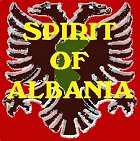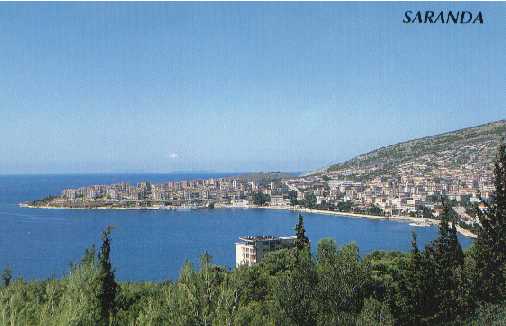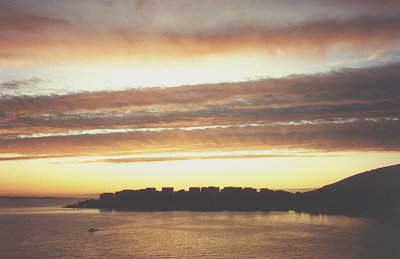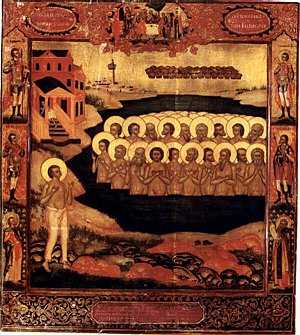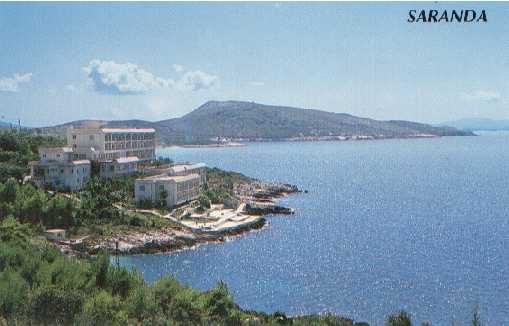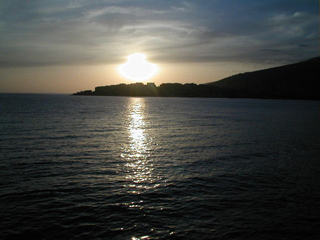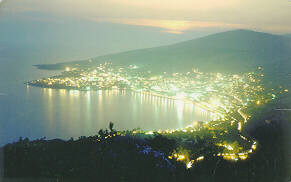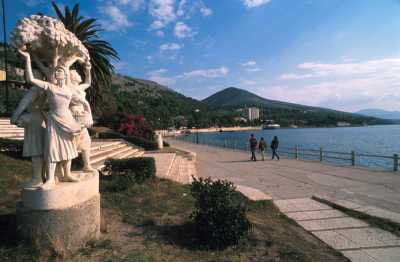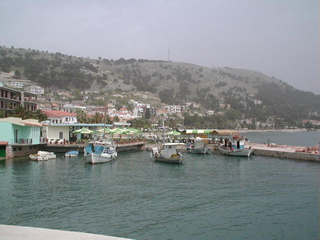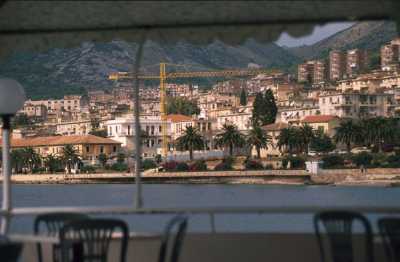|
|
|
Saranda
Saranda (also Sarandė) ancient Onchesmos, is an attractively situated port and seaside town. The town is built back from the pleasant small beach, fringed with palm trees. On the far side of the bay is the harbor and the modern town above the port facilities, with an unattractive collection of blocks of flats. The town has been used by foreign visitors for many years. Day trips can be made by boat from Corfu.
"The sunset in Saranda"- photo by Anthony Weir Saranda has had several names in its long history. In ancient Greek it was called Anchises Harbour, in Roman times, Onchesmus, then Hagia Saranda, "Forty Saints": Saranda is Greek for Forty, a mystical number in both Islam and Christianity (40 days or years in the desert, and so on). So the Saints are either Sufis, or (less likely) the Forty Armenian Martyrs of the fourth century whose story is told at the bottom of this page. Later the Italian form Santi Quaranta became more commonly used.
It was an important base in World War I for the Italian navy between 1915 and 1918. In this pre-war period, Albanians called the town Pirro. The port was called Porto Edda after June 1939 under the Italian annexation, to honour Mussolini's daughter Edda. The population at the time was about 2000 people. The town of Saranda is only a few kilometres from Corfu across the straits, and the town has often been linked with the island in history.
Although originally developed by Greek colonists as the port for Phoinike, and mentioned by Strabo and Ptolemy. Saranda only really became a place of any importance in Roman times, as a stopping point on the sea route between Italy and Greece. Cicero, returning from the east, notes 'a favourable wind from Onchesmus'. It was occupied by Ostrogoth invaders in 551. Most of the remains from this period have disappeared, owing to changes in the sea level. It continued as a small port into Byzantine times, then followed the common pattern of decline of most Albanian coastal centres under the Ottoman occupation. Under Ali Pasha it became the port for the trade to Ioannina (Janina). Between the wars its principal export was dried mullet roe, to Italy. In the Second War Saranda was one of the few places in the Balkans to experience an assault by a British landing force, when in October 1944, 40th Royal Marine Commando captured the port to prevent the evacuation of the German garrison on Corfu.
Saranda is a pleasant place to stay for a day or two, with long hours of sunshine at all times of the year, very mild winters and shelter from strong winds thanks to the surrounding Eremece mountains.
The sunsets are particularly famous, when the island of Corfu seems to float on the surface of the Adriatic. There is a good swimming off the rocks 1 kilometre south of the town. It is also a good base to visit Butrint 15 kilometres south. There are interesting remains of the Roman period in the small town museum, among the shops above the front, which has been built around a mosaic which was discovered there. There are also some exhibits from ancient Phoinike displayed, principally a marble statue of a woman, and a bust of Artemis, dating from the 2nd century AD. More views from Saranda
In front of the hotel Butrinti
A party of soldiers who suffered a cruel death for their faith, near Sebaste, in Lesser Armenia, victims of the persecutions of Licinius, who, after the year 316, persecuted the christians of the East. The earliest account of their martyrdom is given by St. Basil, Bishop of Caesarea (370-379), in a homily delivered on the feast of the Forty Martyrs (Hom. xix in P.G., XXXI, 507 sqq.). The feast is consequently more ancient than the episcopate of Basil, whose eulogy on them was pronounced only fifty or sixty years after martyrdom, which is thus historic beyond a doubt. According to St. Basil, forty soldiers who had openly confessed themselves Christians were condemned by the prefect to be exposed naked upon a frozen pond near Sebaste on a bitterly cold night, that they might feeze to death. Among the confessors, one yielded and, leaving his companions, sought the warm baths near the lake which had been prepared for any who might prove inconstant. One of the guards set to keep watch over the martyrs beheld at this moment a supernatural brilliancy overshadowing them and at once proclaimed himself a Christian, threw off his garments, and placed himself beside the thirty-nine soldiers of Christ. Thus the number of forty remained complete. At daybreak, the stiffened bodies of the confessors, which still showed signs of life, were burned and the ashes cast into a river. The Christians, however, collected the precious remains, and the relics were distributed throught many cities; in this way the veneration paid to the Forty Martyrs became widespread, and numerous churches were erected in their honour. One of them was built at Caesarea, in Cappadocia, and it was in this church that St. Basil publicly delivered his homily. St. Gregory of Nyssa was a special client of these holy martyrs. Two discourses in praise of them, preached by him in the church dedicated to them, are still preserved (P. G., XLVI, 749 sqq., 773 sqq.) and upon the death of his parents, he laid them to rest beside the relics of the confessors. St. Ephraem, the Syrian, has also eulogized the forty Martyrs (Hymni in SS. 40 martyres). Sozomen, who was an eye-witness, has left us (Hist. Eccl., IX, 2) an interesting account of the finding of the relics in Constantinople through the instrumentality of the Empress Pulcheria. Special devotion to the forty martyrs of Sebaste was introduced at an early date into the West. St. gaudentius, Bishop of Brescia in the beginning of the fifth century (d. about 410 or 427), received paticles of the ashes of martyrs during a voyage in the East, and placed them with other relics in the altar of the basilica which he had erected, at the consecration of which he delivered a discourse, still extant (P. L., XX, 959 sqq.) Near the Church of Santa Maria Antiqua, in the Roman Forum, built in the fifth century, a chapel was found, built, like the church itself, on an ancient site, and consecrated to the Forty Martyrs. A picture, still preserved there, dating from the sixth or seventh century, depicts the scene of the martydom. The names of the confessors, as we find them also in later sources, were formerly inscribed on this fresco. Acts of these martyrs, written subsequently, in Greek, Syriac and Latin, are yet extant, also a "Testament" of the Forty Martyrs. Their feast is celebrated in the Greek, as well as in the Latin Church, on 9 March.
Click here to view:
With
thanks to my Irish poet friend
|
